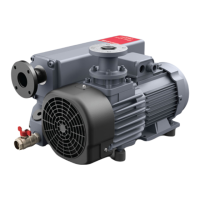▪ Install the pump on a solid, level surface, suitable for taking its weight. Respect the
minimal distance between the pump and the walls (Refer to Dimension drawings
on page 22).
▪ Correct process lines sizes must be used to prevent restricons and resulng
pressure drops. The inlet diameter of the pump should be maintained as far into
the process as possible. Contact us for piping recommendaons.
▪ The required venlaon capacity to limit the vacuum pump room temperature can
be calculated from Qv = 0.2 N/Dt, with:
▪
Qv = required venlaon capacity in m
3
/s
▪
N = sha input of the vacuum pump in kW.
▪
Dt = temperature increase of the incoming venlaon air in the vacuum
pump room in °C
▪
Make sure all piping connecons from the pump to the point of use are leak‑ght
and secure. Leaks add load to the vacuum pump. They decrease the available
pump capacity and prevent the aainable ulmate pressure from being reached.
All welds must be vacuum compable.
▪
Vacuum rated isolaon valves must be used. Compressed air valves and vacuum
valves dier in their sealing characteriscs and compressed air valves may leak in
vacuum applicaons.
▪ All piping should be as straight as possible with non-restricve diameters. Elbows,
bends, tees and tapers should be used only when necessary.
▪
Keep the plumbing and the system free of uids, water, dirt, and debris that are
not part of the process. These can cause obstrucons in the vacuum ow through
the piping and can reduce available pumping capacity.
▪ Exhaust piping should be installed to not create addional back pressure on the
vacuum pump. Also, the exhaust piping should be installed sloping away from the
vacuum pump.
▪
A recommended alternave is the use of a drip leg with drain point provision, to
prevent condensate from running back into the uid reservoir.
▪ Take extreme care in selecng the proper inlet ltraon system for the vacuum
pump. Liquids, solids and abrasive powders must be prevented from entering the
vacuum pump to prevent mechanical failure or reduced lifeme. Inlet ltraon
must be installed on every pump. The potenal for parculate contaminaon in
rough vacuum applicaons is signicant. The parcle micron retenon of the lter
element must be smaller than the smallest possible parcle load. Also, the inlet
lter should be mounted in such a way to prevent parcles from falling into the
inlet of the vacuum pump during cleaning or changing of the lter element.
▪
If there is a risk for liquids to be drawn into the vacuum system, a liquid separator
should be used to separate these liquids from the incoming air. In applicaons
where there is a signicant amount of liquid, contact us.
▪
Keep the vacuum pump room dry and free from contaminaon.
▪
Follow recommended lubricant change schedules in normal applicaons (air) and
watch closely the condion and appearance of the uid in chemical or harsh
applicaons. Check the leak rate of the system by pumping down to the ulmate
pressure and then valve o the vacuum pump. Monitor the pressure rise for ve or
ten minutes and record this rate of rise for future reference. This value is a good
tool to have if you believe there are pump or system problems. Compare new
value with the original.
07/2020 - Page 29
A35104880_B - Installaon

